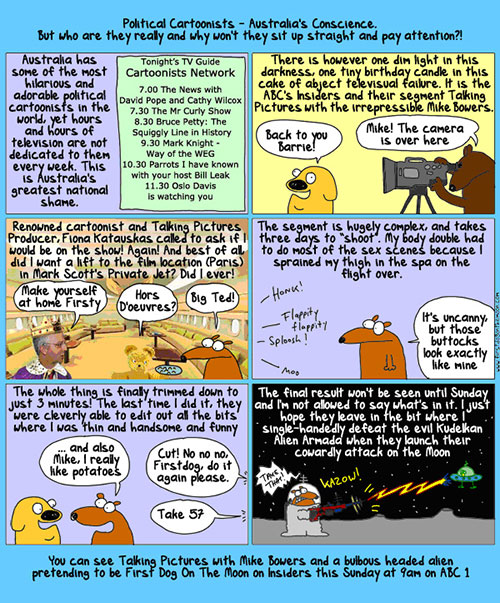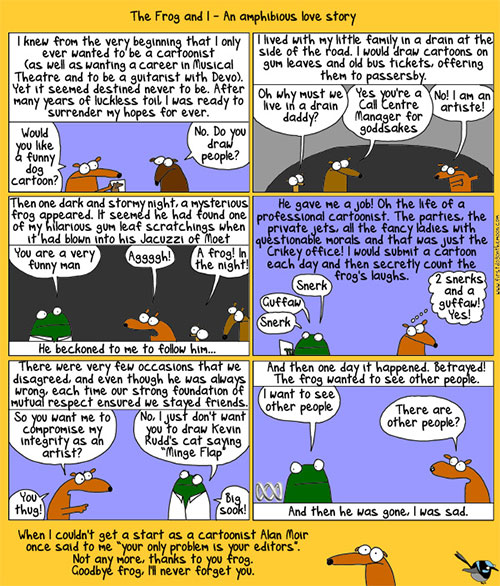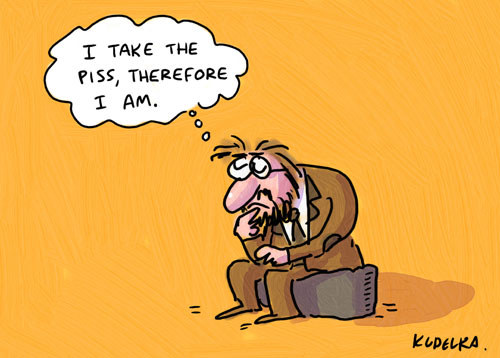Political cartoons (also known as editorial cartoons) are one of the most powerful parts of the news media because they’re capable of dissecting complex issues, pointing out the elephant in the room and ridiculing powerful figures in society far more succinctly than a political journalist can using hundreds or even thousands of words.
According to the Australian Culture Portal:
Australia has a strong and vibrant history of political cartooning. Since the 1830s, when political cartoons were first featured in Australian newspapers, they have provided satirical, witty or humorous comment on political and public affairs, social customs, fashions, sports events and personalities.
…
A picture, as they say, is worth a thousand words, and political cartoons and caricatures have traditionally been a devastating method of cutting the powerful and the proud down to size.
Two of my favourite Australian political cartoonists are cartoonist for Crikey.com.au First Dog on The Moon (whose human representative is Andrew Marlton) and Jon Kudelka freelancer for several Australian News Corporation newspapers.
Neerav Bhatt: First Dog On the Moon please tell readers about yourself? Were you really a call centre manager before joining Crikey?
First Dog On the Moon: Yes I was. I have a deep and abiding passion for call centres. They are the evolutionary peak of capitalism. Also, they can be really sh*t places to work unless you avoid work by becoming the call centre manager. The thing I enjoyed most about them was the machines and the systems. I love a good realtime graph. And there is nothing like a well set up PABX. Nothing.
Neerav Bhatt: Jon I know you currently sell cartoons to The Australian, The Hobart Mercury and The Sunday Telegraph. What’s your background besides liking coffee and being mostly left handed? Unlike Andrew you don’t feature yourself as a character in your published cartoons. Are there any cartoons or illustrations in your archive that tell your tale best?
Jon Kudelka: That cartoon pretty much sums up cartoonists, except we don’t wear ties. My backstory is much less exciting than Mr Dog’s. I got a degree in science, did science a favour and became a cartoonist, the rest is history. The only other job I’ve ever had was picking apples, but everyone in Tasmania does that.
Neerav Bhatt: Which of your cartoons do you feel has made the most impact?
First Dog On the Moon: It depends on what you mean by impact. The one I drew when my cat died, probably illicited the most emotional response I ever got. The one about Bad Parking Girl got a huge response too, everybody hated bad parking girl. The Death of Capitalism remains a favourite for loads of people, I still sell quite a few t-shirts of that one.
Jon Kudelka: I am constantly shocked and dismayed by the consistent lack of wholesale political resignations upon publication of my work. These people have no shame.
When you’re knocking out nine or ten a week it’s best to treat the whole thing as a conversation and keep your mind on what you’re going to say next, but I did like Welcome to Brendan probably because it won an award. Awards are lovely.
EDITOR: Jon won a prestigious Walkley award for a depiction of then opposition leader Brendan Nelson
Neerav Bhatt: Political cartoonists have traditionally worked as staff or freelancers associated with newspapers but this form of media is slowly dying. What will happen if/when News Corp and Fairfax decide they don’t want or can’t afford political cartoonists like Michael Leunig (the Age), Alan Moir (Sydney Morning Herald), Warren Brown (Daily Telegraph) etc anymore?
First Dog On the Moon: That won’t happen. A cartoon is a cartoon whether it is online or on paper. Everyone loves cartoons, except people who don’t and they are broken and sad.
Jon Kudelka: Newspapers are dying? Why did nobody tell me?
But semi-seriously, newspapers have been dying for so long now I’m starting to think the whole thing was made up by climate change scientists in their spare time. However, if newspapers do decide they don’t want to pay for cartoonists any more, then I will probably have to sell the other jet. I don’t think this will happen. The transition between paper and pixels will no doubt be a bit ugly, but newspapers will muddle through. Or we’re all stuffed.
Neerav Bhatt: Would you still draw and publish political cartoons on the internet if you couldn’t earn a living from cartooning and had to do a more mundane job for a living?
First Dog On the Moon: Yes – that’s what I did before – I would do it again – although I would paint more. And I would lie down more too.
Jon Kudelka: Political cartooning is really easy to do, but it is quite hard work to do it well, so I would need to make it pay to keep on doing it.
As I (and this is probably true of most political cartoonists) am completely unemployable outside of cartooning in some shape or form, I would try and find some way of making a living out of it, and I’m sure that would involve the internet in some way. Or not. This is a rather depressing line of questioning. Ask me about political cartoonist syndicates.
Neerav Bhatt: What do you think of political cartoonist syndicates such as the one run by American cartoonist Daryl Cagle
First Dog On the Moon: I note there is an absence of that sort of thing over here, however there are SO MANY OF THEM over there. It is quite good.
Jon Kudelka: I think they turn an art form into a commodity, which I suppose is the point of commercial art, but I’m not sure they’re a good idea.
My feeling is that you need to make a political cartoon a bit of an event, and pinning them up like dead butterflies isn’t a great look. Political cartoons also work best in context with a bit of serious news around them and are a bit overwhelming en masse, kind of like all main course and no dessert. These are just general misgivings as I haven’t actually thought that much about it, and if a syndicate would like to pay me a million bucks a year to run my cartoons, I am willing to change my mind.
Large collections also tend to highlight how lots of political cartoonists come up with the same ideas. Best keep that a secret, I say.
Neerav Bhatt: Do you think letting fans display your cartoons on their website using widget embed code is a good idea? I’ve written about this before at Gary Larson vs Scott Adams: How Comic Strip Creators Interact With Fans
Have you considered doing it for your cartoons so that you get proper credit for your work and at the very least your site gets more links to it rather than people stealing cartoon images and hosting them on their own sites?
First Dog On the Moon: Sure, as long as it doesn’t eat the money. Being behind a paywall does have its limitations. But I am always happy for people to share the cartoons around within reason.
Jon Kudelka: I really don’t know. Good question. Has anyone discovered a way of making money out of the internet that doesn’t involve nudity?
Neerav Bhatt: Have you had much success earning income from selling originals/prints, merchandise or books? Do you get to keep all the revenue or does Crikey/News Corp get a cut?
First Dog On the Moon: I have an “arrangement” with Crikey in which I am exploited horribly. They are dreadful, dreadful people.
Jon Kudelka: The 101 Uses For A John Howard book (from the blog) was a big success financially, however this was a bit of a one-off. Prints and originals sell pretty well off the website. I get all the cash, but if I had a day job I wouldn’t be giving it up.
Neerav Bhatt: What are the best ways for your fans to support you? Buy merchandise/prints? Email your editors and tell them how great you are?
First Dog On the Moon: The best way for fans to support me is to subscribe to Crikey and then email saying, I subscribed to Crikey solely because of First Dog On The Moon who is a total legend. And then buy a t-shirt or eleven.
Jon Kudelka: I have fans? This is good news. They should send cash in unmarked bills if they feel that strongly about it. If they want to buy some stuff, they should, but don’t feel obliged. I’ll be okay.
Further Resources
Knight Digital Media Center : Can the Internet rejuvenate editorial cartooning?
A few practice lessons for kids who want to be a political cartoonist
American cartoonist Daryl Cagle’s cartoonist syndicate
First Dog On the Moon appearance 1 and 2 on ABC’s Insiders “Talking pictures” segment
Jon Kudelka’s appearances on ABC’s Insiders “Talking pictures” over the years. You can find most of them via the search results page on the ABC website.
Behind the Scenes of ABC TV Insiders
If you can find a copy at a local library there was a great ABC program in 2003 called “Hired assassins: political cartooning in Australia”




Leave a Reply